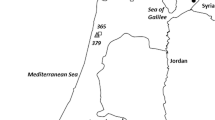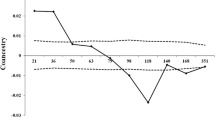Abstract
RAPD markers were used to investigate the distribution of genetic variability in a germplasm collection of the dioecious tropical tree Aroeira (Myracrodruon urundeuva) composed of open pollinated maternal half-sib families collected from trees at least 300 meters apart and grouped in nine collection areas throughout its geographical range in Brazil. Open pollinated families from nearby trees from two natural populations were also included in the study. A Principal Coordinate Analysis (PCO) based on genetic similarities estimated with 83 RAPD markers showed no defined clustering among individuals from the same collection areas. However, a matrix correlation test showed low, but significant correlation between genetic and geographic distances (r = 0.17; p < 0.02). An AMOVA showed that 92% of the genetic variation is found within collection areas. Significant variation was found both between regions and between areas within regions although only 3.54 and 4.44% of the variation was found at these levels respectively. An AMOVA on the individuals from the two natural populations resulted in a pattern of distribution congruent to the one found for the collection areas, with 97% of variability within populations. An analysis of 10 open-pollinated half-sib families revealed that between 75% and 89% of the variability is contained within families, suggesting that seeds from one tree represent a significant proportion of the variability found in the population. These results indicate that, either for the establishment of in situ genetic reserves or for ex situ conservation, efforts should be directed to the conservation of several individual trees or collection of open pollinated seed families in a few distant sites. In addition, if resources are available to enlarge the genetic base of the existing collection, expeditions should prioritize collection sites located in areas at significant distances to those already sampled.
Similar content being viewed by others
References
Bawa K.S. 1992. Mating systems, genetic differentiation and speciation in tropical rain forest plants. Biotropica 24: 250–255.
Bawa K.S. and Ashton P.S. 1991. Conservation of rare trees in tropical Rain Forests. A genetic perspective. In: Falk D.D. and Holsinger K.E. (eds), Genetic and conservation of rare plants. Oxford University Press, New York, pp. 62–71.
Caetano-Anollés G. 1996. Scanning of nucleic acids by in vitro amplification. New developments and applications. Nature Biotechnology 14: 1668–1674.
Collevatti R.G., Grattapaglia D. and Hay J.D. 2001. High resolution microsatellite based analysis of the mating system allows the detection of significant biparental inbreeding in Caryocar brasiliense, an endangered tropical tree species. Heredity 86: 60–67.
Dawson I.K. and Powell W. 1999. Genetic variation in the Afromontane tree Prunus africana, an endagered medicinal species. Molecular Ecology 8: 151–156.
Dice L.R. 1945. Measures of the amount of ecologic association between species. Ecology 26: 297–302.
Doyle J.J. and Doyle J.L. 1990. Isolation of plant DNA from fresh tissue. Focus 12: 13–15.
Ellsworth D.L., Rittenhouse K.D. and Honeycutt R.L. 1993. Arti-factual variation in randomly amplified polimorphic DNA band-ing patterns. Biotechniques 14: 214–217.
Excoffier L., Smouse P.E. and Quattro J.M. 1992. Analysis of molecular variance inferred from metric distances among DNA haplotypes. application to human mitochondrial DNA restriction data. Genetics 131: 479–491.
FAO, 1984. A Guide to in situ conservation of genetic resources of tropical woody species. Based on the work of L. Roche & Durojeanni. Rome (FORGEN/MISC/84/ 2.).
Furman B.J., Grattapaglia D., Dvorak W.S. and O'Malley D.M. 1997. Analysis of genetic relationships of central american and mexican pines using RAPD markers that distinguish species. Molecular Ecology 6: 321–332.
Grattapaglia D. and Sederoff R.R. 1994. Genetic linkage maps of Eucalyptus grandis and E. urophylla using a pseudo-testcross strategy and RAPD markers. Genetics 137: 1121–1137.
Hallden C., Hansen M., Nilsson N.O., Hjerdin A. and Sall T. 1996. Competition as a source of errors in RAPD analysis. Theoretical and Applied Genetics 93: 1185–1192.
Hogbin P.M., Ayre D.J. and Whelan R.J. 1998. Genetic variation and reproductive success of road verge populations of the rare schrub Grevillea barklyana (Proteaceae). Heredity 80: 180–186.
IBAMA-Instituto Brasileiro do Meio Ambiente e dos Recursos Naturais Renováveis, 1992. Lista oficial de espécies da flora brasileira ameaç?das de extinção. Diário Oficial, Brasília, 23 de janeiro de 1992, pp. 869–873.
Karp A., Edwards K.J., Bruford M., Funk S., Vosman B., Morgante M. et al. 1997. Molecular technologies for biodiversity evalua-tion. Opportunities and challenges – New technologies for detecting variation in DNA complement traditional methods in biodiversity. Nature Biotechnology 15: 625–628.
Jordano P. and Godoy A. 2000. RAPD variation and population genetic structure in Prunus mahaleb (Rosaceae), an animal-dispersed tree. Molecular Ecology 9: 1293–1305.
Lacerda C.M.B. 1997. Diversidade genética por isoenzimas em populações de Aroeira (Myracrodruon urundeuva) Anacar-diaceae no semi-árido, M.Sc., University of São Paulo.
Lacerda D.R., Acedo M.D.P., Lemos Filho J.P. and Lovato M.B. 2001. Genetic diversity and structure of natural populations of Plathymenia reticulata (Mimosoideae), a tropical tree from the Brazilian Cerrado. Molecular Ecology 10: 1143–1152.
Lemes M.R., Brondani R.P.V. and Grattapaglia D. 2002. Multiplex-ed systems of microsatellite markers for genetic analysis in mahogany, Swietenia macrophylla King (Meliaceae), a threat-ened Neotropical timber species. Journal of Heredity 93: 287–291.
Li X., Huang Y., Li J. and Corke H. 2001. Characterization of genetic variation and relationships among Choix germplasm accessions using RAPD markers. Genetic Resources and Crop Evolution 48: 189–194.
Loveless M.D. and Hamrick J.L. 1984. Ecological determinants of genetic structure in plant populations. Annual Review of Ecolo gy Systematics 15: 65–95.
Maguire T.L. and Sedgley M. 1997. Genetic diversity in Banksia and Dryandra (Proteaceae) with emphasis on Banksia cuneata, a rare and endangered species. Heredity 79: 394–401.
Mantel N.A. 1967. The detection of disease clustering and a generalized regression approach. Cancer Research 27: 209–220.
Moraes M.L.T. 1992. Variabilidade genética por isoenzimas e caracteres quantitativos em duas populações naturais de Aroeira Myracrodruon urundeuva, Ph.D., University of São Paulo 139 p.
Moretzsohn M.C., Ferreira M.A., Amaral Z.P.S., Coelho P.J.A., Grattapaglia D. and Ferreira M.E. 2002. Genetic diversity of Brazilian oil palm (Elaeis oleifera H.B.K.) germplasm collected in the Amazon Forest. Euphytica 124: 35–45.
Nason J.D. and Hamrick J.L. 1997. Reproductive and genetic consequences of forest fragmentation. two case studies of neo-tropical canopy trees. Journal of Heredity 88: 264–276.
Nei M. and Li W.H. 1979. Mathematical model for studying genetic variation in terms of restriction endonucleases. Proc. Natl. Acad. Sci. USA 76: 5269–5273.
Nesbitt K.A., Potts B.M., Vaillancourt K.E., West A.K. and Reid J.B. 1995. Partitioning and distribution of RAPD variation in a forest tree species, Eucalyptus globulus (Myrtaceae). Heredity 74: 628–637.
Rafalski J.N., Vogel J.M., Morgante M., Powell W., Andre C. and Tingey S.V. 1996. Generating and using DNA markers in plants. In: Birren B. and Lai E. (eds), Nonmammalian genomic analysis. A practical guide. Academic Press, San Diego, pp. 75–133.
Rizzini C.T. 1971. Árvores e madeiras Úteis do Brasil. manual de dendrologia brasileira. Edgard Blucher Ltda, São Paulo, Ed.
Rohlf, F.J., 1997. NTSYS-pc numerical taxonomy and multivariate analysis system. vers. 2.0. Exeter Software, Setauket, NY.
Rossetto M., Weaver P.K. and Dixon K.W. 1995. Use of RAPD analysis in devising conservation strategies for the rare and endangered Grevillea scapigera (Proteaceae). Molecular Ecolo-gy 4: 321–329.
Salomão A.N. and Leite A.M.C. 1993. Comportamento de re-generantes de Astroniun urundeuva (Fr. All.) Engler em área sob ação antrópica. Acta Bot. Bras. 6: 85–96.
Schneider S., Kueffer J.M., Roessli D. and Excoffier L. 1997. Arlequin Ver. 1.1. A software for population genetic data analysis. Genetics and Biometry Laboratory, University of Geneva, Switzerland.
Sheely D.L. and Meagher T.R. 1996. Genetic diversity in mi-cronesian island populations of the tropical tree Campnosperma brevipetiolata (Anacardiaceae). American Journal of Botany 83: 1571–1579.
Troggio M., Kubisiak T.L., Bucci G. and Menozzi M. 2001. Randomly amplified polymorphic DNA linkage relationships in different Norway spruce populations. Canadian Journal of Forest Research 31: 1–6.
Williams J.G., Kubelik A.R., Livak K.J., Rafalski J.A. and Tingey S.V. 1990. DNA polymorphism amplified by arbitrary primers are useful as genetic markers. Nucleic Acids Research 18: 6531–6535.
Yeh F.C., Chong K.D.X. and Yang R.C. 1995. RAPD variation within and among natural populations of trembling aspen (Populus tremuloides Michx.) from Alberta. Journal of Heredity 86: 454–460.
Author information
Authors and Affiliations
Rights and permissions
About this article
Cite this article
Moreira Reis, A.M., Grattapaglia, D. RAPD variation in a germplasm collection of Myracrodruon urundeuva (Anacardiaceae), an endangered tropical tree: Recommendations for conservation. Genetic Resources and Crop Evolution 51, 529–538 (2004). https://doi.org/10.1023/B:GRES.0000024159.48644.e6
Issue Date:
DOI: https://doi.org/10.1023/B:GRES.0000024159.48644.e6




